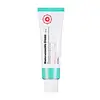What's inside
What's inside
 Key Ingredients
Key Ingredients

 Benefits
Benefits

 Concerns
Concerns

 Ingredients Side-by-side
Ingredients Side-by-side

Centella Asiatica Leaf Water
Skin ConditioningWater
Skin ConditioningCyclopentasiloxane
EmollientPropanediol
SolventPhenyl Trimethicone
Skin ConditioningGlycerin
HumectantPEG-10 Dimethicone
Skin ConditioningNiacinamide
SmoothingCyclohexasiloxane
EmollientPanthenol
Skin ConditioningEthoxydiglycol
HumectantDisteardimonium Hectorite
StabilisingSodium Chloride
MaskingRubus Suavissimus Leaf Extract
Skin ConditioningCentella Asiatica Extract
CleansingCaprylyl Glycol
EmollientPinus Densiflora Leaf Extract
AntimicrobialHamamelis Virginiana Leaf Extract
Skin ConditioningDimethicone Crosspolymer
Emulsion StabilisingCamellia Sinensis Leaf Extract
AntimicrobialButylene Glycol
HumectantMadecassoside
AntioxidantPentylene Glycol
Skin ConditioningCaprylhydroxamic Acid
Adenosine
Skin ConditioningLactic Acid
BufferingSodium Lactate
BufferingUrea
BufferingSerine
MaskingDisodium EDTA
Sorbitol
HumectantCitrus Grandis Peel Oil
MaskingAsiaticoside
AntioxidantCitrus Limon Peel Oil
MaskingPelargonium Graveolens Flower Oil
MaskingLavandula Hybrida Oil
EmollientJuniperus Mexicana Oil
MaskingCitrus Nobilis Peel Oil
MaskingAllantoin
Skin ConditioningChlorphenesin
AntimicrobialPhenoxyethanol
PreservativeCentella Asiatica Leaf Water, Water, Cyclopentasiloxane, Propanediol, Phenyl Trimethicone, Glycerin, PEG-10 Dimethicone, Niacinamide, Cyclohexasiloxane, Panthenol, Ethoxydiglycol, Disteardimonium Hectorite, Sodium Chloride, Rubus Suavissimus Leaf Extract, Centella Asiatica Extract, Caprylyl Glycol, Pinus Densiflora Leaf Extract, Hamamelis Virginiana Leaf Extract, Dimethicone Crosspolymer, Camellia Sinensis Leaf Extract, Butylene Glycol, Madecassoside, Pentylene Glycol, Caprylhydroxamic Acid, Adenosine, Lactic Acid, Sodium Lactate, Urea, Serine, Disodium EDTA, Sorbitol, Citrus Grandis Peel Oil, Asiaticoside, Citrus Limon Peel Oil, Pelargonium Graveolens Flower Oil, Lavandula Hybrida Oil, Juniperus Mexicana Oil, Citrus Nobilis Peel Oil, Allantoin, Chlorphenesin, Phenoxyethanol
Stearyl Glycyrrhetinate
Skin ConditioningWater
Skin ConditioningParaffinum Liquidum
EmollientPetrolatum
EmollientDipropylene Glycol
HumectantButylene Glycol
HumectantSqualane
EmollientGlycerin
HumectantGlyceryl Stearate Se
EmulsifyingCetearyl Alcohol
EmollientBehenyl Alcohol
EmollientGlycol Stearate
EmollientSerine
MaskingCeramide NP
Skin ConditioningTocopherol
AntioxidantUbiquinone
AntioxidantCetyl Ethylhexanoate
EmollientAcrylic Acid
Acrylates/C12-22 Alkyl Methacrylate Copolymer
Isostearic Acid
CleansingDisodium EDTA
Hydroxyethylcellulose
Emulsion StabilisingDimethicone
EmollientSodium Hydroxide
BufferingPhenoxyethanol
PreservativeStearyl Glycyrrhetinate, Water, Paraffinum Liquidum, Petrolatum, Dipropylene Glycol, Butylene Glycol, Squalane, Glycerin, Glyceryl Stearate Se, Cetearyl Alcohol, Behenyl Alcohol, Glycol Stearate, Serine, Ceramide NP, Tocopherol, Ubiquinone, Cetyl Ethylhexanoate, Acrylic Acid, Acrylates/C12-22 Alkyl Methacrylate Copolymer, Isostearic Acid, Disodium EDTA, Hydroxyethylcellulose, Dimethicone, Sodium Hydroxide, Phenoxyethanol
Ingredients Explained
These ingredients are found in both products.
Ingredients higher up in an ingredient list are typically present in a larger amount.
Butylene Glycol (or BG) is used within cosmetic products for a few different reasons:
Overall, Butylene Glycol is a safe and well-rounded ingredient that works well with other ingredients.
Though this ingredient works well with most skin types, some people with sensitive skin may experience a reaction such as allergic rashes, closed comedones, or itchiness.
Learn more about Butylene GlycolDisodium EDTA plays a role in making products more stable by aiding other preservatives.
It is a chelating agent, meaning it neutralizes metal ions that may be found in a product.
Disodium EDTA is a salt of edetic acid and is found to be safe in cosmetic ingredients.
Learn more about Disodium EDTAGlycerin is already naturally found in your skin. It helps moisturize and protect your skin.
A study from 2016 found glycerin to be more effective as a humectant than AHAs and hyaluronic acid.
As a humectant, it helps the skin stay hydrated by pulling moisture to your skin. The low molecular weight of glycerin allows it to pull moisture into the deeper layers of your skin.
Hydrated skin improves your skin barrier; Your skin barrier helps protect against irritants and bacteria.
Glycerin has also been found to have antimicrobial and antiviral properties. Due to these properties, glycerin is often used in wound and burn treatments.
In cosmetics, glycerin is usually derived from plants such as soybean or palm. However, it can also be sourced from animals, such as tallow or animal fat.
This ingredient is organic, colorless, odorless, and non-toxic.
Glycerin is the name for this ingredient in American English. British English uses Glycerol/Glycerine.
Learn more about GlycerinPhenoxyethanol is a preservative that has germicide, antimicrobial, and aromatic properties. Studies show that phenoxyethanol can prevent microbial growth. By itself, it has a scent that is similar to that of a rose.
It's often used in formulations along with Caprylyl Glycol to preserve the shelf life of products.
Serine is an amino acid naturally found in our body. Our bodies use amino acids to create protein.
Amino-acids help give keep our skin hydrated. They play an important role in the skin barrier, which keeps the skin plump and firm.
Serine is a non-essential amino acid, meaning we don't need to obtain it from eating foods.
Learn more about SerineWater. It's the most common cosmetic ingredient of all. You'll usually see it at the top of ingredient lists, meaning that it makes up the largest part of the product.
So why is it so popular? Water most often acts as a solvent - this means that it helps dissolve other ingredients into the formulation.
You'll also recognize water as that liquid we all need to stay alive. If you see this, drink a glass of water. Stay hydrated!
Learn more about Water